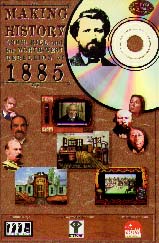|
________________
CM . . . .
Volume V Number 12 . . . . February 12, 1999
To run Making History you need:
This is a valuable, user-friendly CD about the North-West Rebellion of 1885.
Information is presented in an exciting, creative and historically sound
manner. The interactive nature of the CD allows for critical thinking,
interpretation and evaluation of the historical events by the student. The
print is easily readable, and the reading level is certainly Senior High. The
program is exceedingly comprehensive and History students at the Senior or
Post-Secondary levels should be able to interact with the CD either
individually or within a lab setting.
The "Teacher's Guide" has four parts: Background; Learning History;
Applications; and The Journal. The program allows the student to explore
original material from newspaper articles, photographs and interviews with
historical characters. The Guide offers excellent suggestions for group work
and how to set up discussions. You are able to print only what you need for
your purposes. Background information is given for the cartoons, and answers
are supplied for the crossword puzzles. There is a guide for the use of The
Journal. The student can save and print collected files in which information
can be used as quotations or used to create the student's own multimedia
research paper.
Once you have traveled by train to "The North-West Pavilion of 1885," you can
gain access to the seven rooms of information. I would recommend starting in
"The Pavilion Theatre" where a four act play presents background information to
The Rebellion using actual pictures, drawings and photographs plus better music
relevant to the topic. Two historians, G. Woodcock and P. Chartrand, express
their perspectives about the era described. Another room, "The Newspaper Room,"
contains four Bulletin Boards dealing with Policy, The Rebellion, the Railway
and the Hanging of Riel. For any cartoons used, the cursor becomes a magnifying
glass to enhance details. The Newspaper Index is chronological, and it is easy
to use. The Map of the 1885 Pavilion is present throughout various areas so
that you can move from area to area easily.
In "The Map Room," you are able to choose rolls of maps that can be placed on a
table in the centre of the room. The maps can be stacked, and each one can be
saved easily for the student's own document. Only the maps from one collection
at a time can be kept on the table. The maps are clear and appropriate to the
information provided.
"The Documents Library" contains actual letters, documents, trial transcripts,
telegraph messages, Hansard/Laws and Reports, Treaty #6 and Hudson's Bay
Company advertisements for new products. One realistic note is that you hear
the sound of pages turning as you look through the various documents.
"The Trading Post" contains Albums of original photographs and animated
postcards that deal with such issues as the demise of the bison.
In "The Kinetoscope Arcade," nine principal characters of the Rebellion such as
Louis Riel and Poundmaker, can be interviewed. Questions are given, and answers
from different points of view are discussed by the two historians, Woodcock and
Chartrand. The reference feature can be utilized here to explore related
sources further.
Throughout the "Hallways and Verandah" segment, pictures of the prairie
landscape, characters and artifacts relevant to The Rebellion offer further
interactive information. It is important to see the types of evidence, whether
primary or secondary sources of information used by the historians to support
their point of view.
"The Reference Room" offers information on the following topics: Timeline of
1867-1906, Bibliography, Glossary of useful terms and Acknowledgments/Credits
for the CD.
All History teachers should be informed of this CD's existence as it makes this
period of history come alive.
Highly recommended.
Gary Evans is a Winnipeg Social Studies teacher who also instructs in the
Faculty of Education, the University of Manitoba.
To comment on this title or this review, send mail to cm@umanitoba.ca.
Copyright © the Manitoba Library Association.
Reproduction for personal use is permitted only if this copyright notice
is maintained. Any other reproduction is prohibited without
permission.
Published by
TABLE OF CONTENTS FOR THIS ISSUE - FEBRUARY 12, 1999.
AUTHORS |
TITLES |
MEDIA REVIEWS |
PROFILES |
BACK ISSUES |
SEARCH |
CMARCHIVE |
HOME
|

